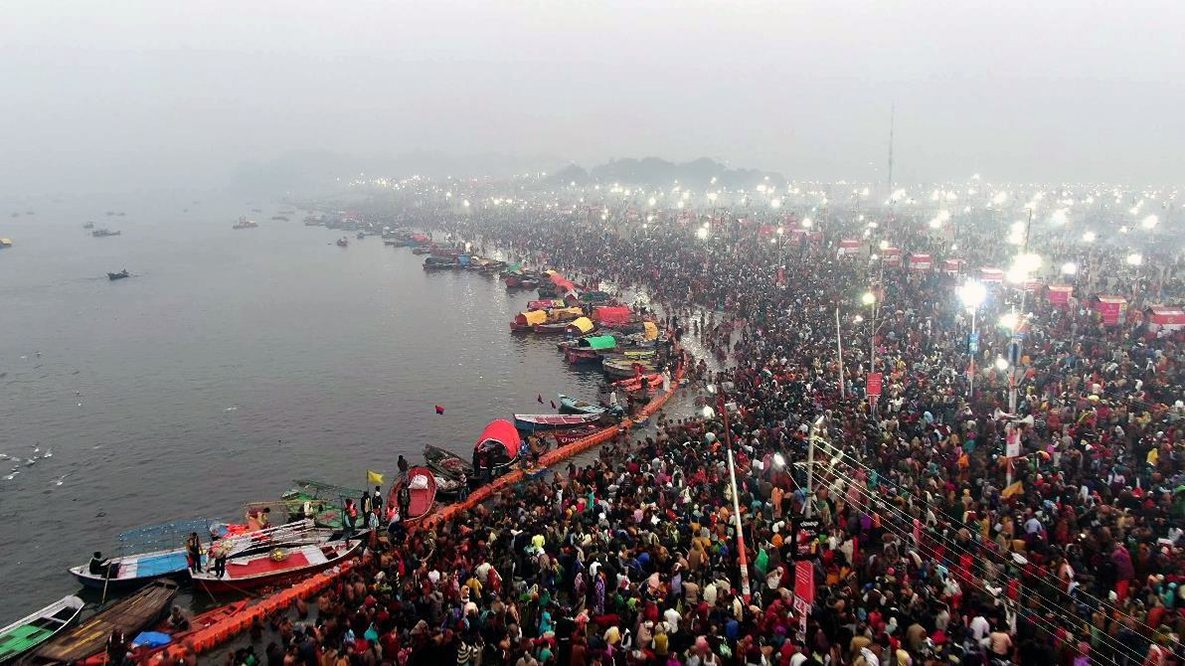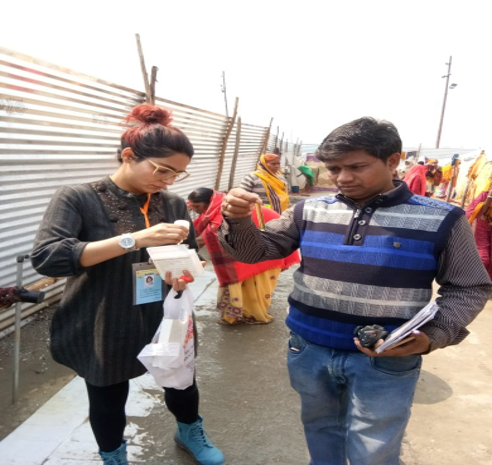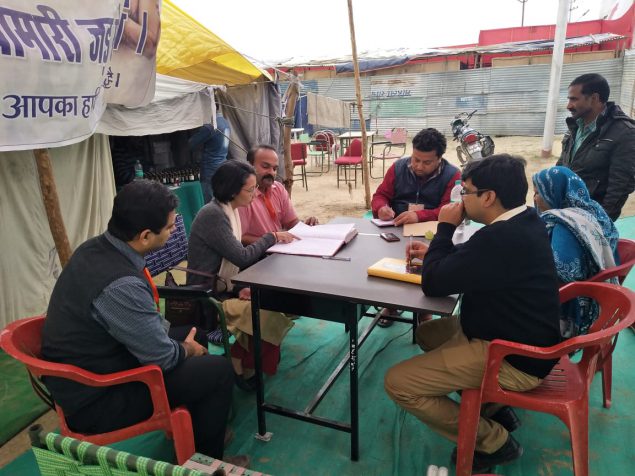CDC India helps protect 150 million people at the world’s largest gathering
Story by Kelley Raines, CDC Global Health Intern

Kumbh Mela mass gathering for holy dip in Prayagraj, India, January-March 2019
Photo credit: Kumbh Mela, 2019, Official government website.
Imagine 150 million people – over 17 times the population of New York City – coming together in peaceful celebration. Through the course of a six-week pilgrimage, people from different parts of the Hindu religious life make their way down along the banks of the Ganges River in Uttar Pradesh, India, where three holy rivers converge. The daily foot traffic in this region can exceed 30 million as devotees gather to participate in the ritual of bathing in the river to wash away their sins. This is Kumbh Mela, the world’s largest gathering of humanity. This Hindu religious festival is celebrated four times in a 12-year cycle, the latest taking place January- March of 2019.
Although Kumbh Mela is a time for celebration, an event of this size presents significant public health concerns. With millions of people coming so closely together, the potential for the rapid spread of diseases is a real threat to public safety. Recognizing the potential for disease outbreaks, the state of Uttar Pradesh and the Government of India entrusted the National Centre for Disease Control (NCDC), with support from CDC India and World Health Organization (WHO) India Country Office, to conduct the surveillance and response efforts needed to protect public health. The CDC India team provided technical and laboratory assistance, in collaboration with NCDC and WHO India, before, during, and after Kumbh Mela to protect human lives and prevent the spread of disease during the mass gathering.

(India EIS Officer from NCDC is testing the water quality in the Kumbh Mela area. Photo credit: Dr. Rajesh Yadav)
Preparing for Kumbh Mela

(Laboratory training at the Kumbh Mela, Allanhabad. Photo Credit: Indranil Roy, Lab Advisor, USG)
Before Kumbh Mela, CDC India co-led two series of workshops to build local disease surveillance and laboratory capacity. To ensure active disease surveillance during the gathering, more than 100 government and private clinical providers were trained on case definitions, reporting methods, and a tablet-based Integrated Health Information Platform. To increase laboratory capacity, CDC India and partners trained more than 100 government laboratory and nursing staff on sample collection, labelling, safe packaging and transport, personal protective equipment, and rapid diagnostic tests.
In addition, CDC India supplied rapid, point-of-care test kits for cholera to increase the state’s ability to test for the disease. To prevent water-borne diseases and ensure safety, CDC India and partners also conducted trainings for sanitation workers on monitoring bacteria and estimating the amount of chlorine needed for safe drinking water. Together, these efforts prepared local staff to monitor and respond to emerging disease threats during the event.

(CDC India laboratory training session, Jan 2019. Photo credit: Dr. Mayank Dwivedi)

(India EIS Officer from WHO is interacting with children during a diarrheal disease outbreak investigation at Kumbh Mela. Photo credit: Dr. Rajesh Yadav)
During Kumbh Mela
During Kumbh Mela, CDC India helped establish a field Emergency Operations Center (EOC). This served as a centralized location where experts monitored information, prepared for known and unknown events, and responded to new developments.
DC India’s Dr. Rajesh Yadav was one of several prominent figures working on the ground during Kumbh Mela. Among other accomplishments, Dr. Yadav provided outbreak investigation training and mentorship for NCDC and WHO Epidemic Intelligence Service (EIS) officers, as well as on-site assistance for real-time disease surveillance over the six-week period. Dr. Yadav says, “CDC India’s workforce, laboratory, and emergency response teams worked together to support the 2019 Kumbh Mela public health response in coordination with the Government of India, which strengthened critical partnerships under the Global Health Security Agenda.”
Real-time surveillance for 22 diseases was established across 69 reporting sites, resulting in almost 750,000 reported health events. Supported by CDC India, EIS officers from NCDC and WHO responded to three outbreaks – diarrheal diseases, chicken pox, and malaria – to stop the spread of disease and prevent additional deaths and illnesses. Collaboration between CDC, NCDC, and WHO to support and respond with local health officials led to an effective, efficient, and timely response.

(India EIS officers from NCDC are reviewing the out-patient register formats at a field unit while planning the daily disease surveillance at Kumbh mela. Photo credit: Dr. Rajesh Yadav)

(Kumbh Mela staff outside the Integrated Disease Surveillance System. photo credit: Dr. Rajesh Yadav)
After Kumbh Mela
After Kumbh Mela, CDC India provided critical assistance for an after-action review workshop. The team generated a report on lessons learned which will be used to inform preparedness and planning activities for the next Kumbh Mela in 2021.
Thanks to CDC India’s outstanding collaborative public health leadership during the world’s largest mass-gathering, potentially dangerous diseases were detected, and negative health events were minimized. CDC continues to prevent, detect, and respond to diseases around the globe to protect our nation against global health threats.